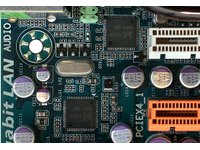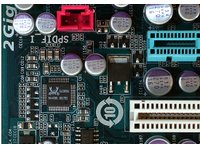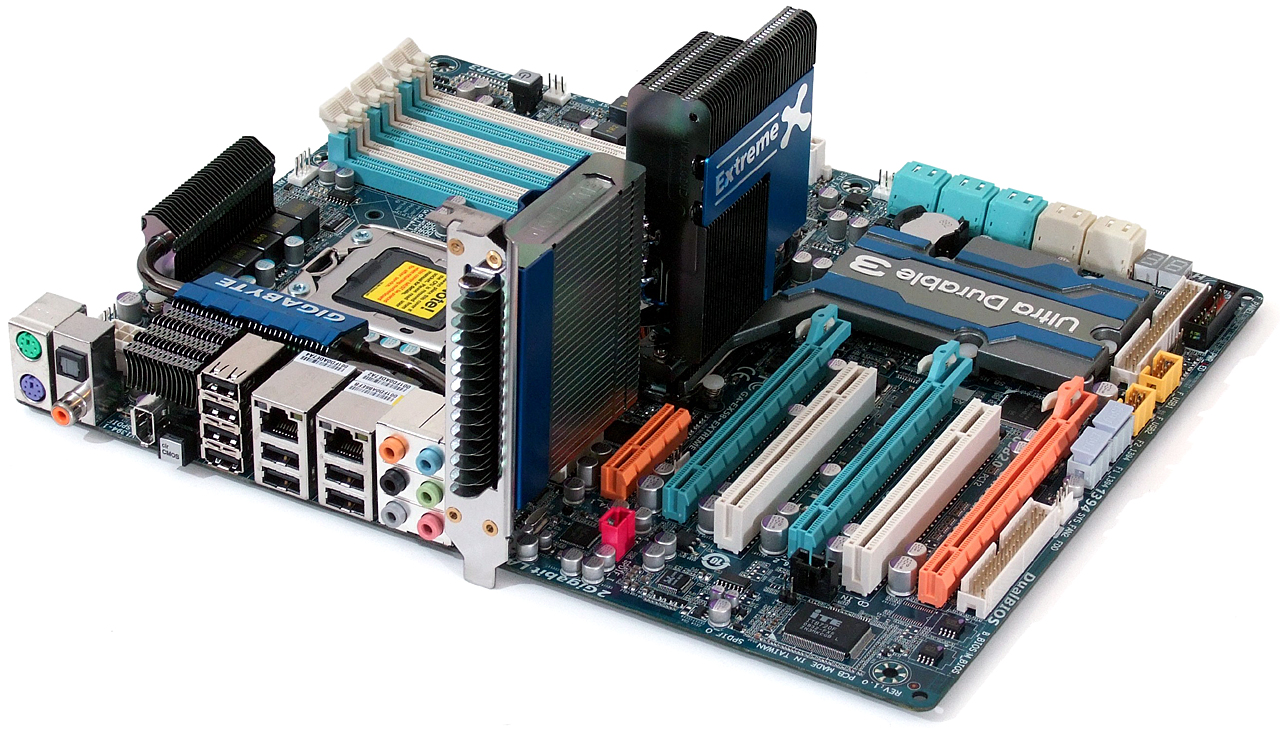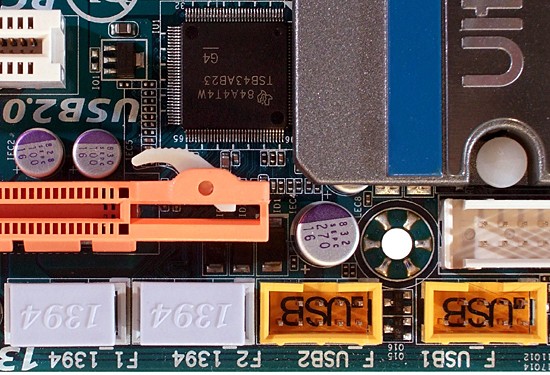Intel X58 Roundup: Six $300+ Platforms Compared
Gigabyte GA-EX58-Extreme
Features and Layout
Gigabyte’s take on extreme overclocking motherboards is inclusive of other high-end markets, as its GA-EX58-Extreme includes oversized cooling, ostensible support for 3-way SLI, and support for up to six DDR3 memory modules. That pits it squarely against Asus’ Rampage II Extreme, but with less “bling” to thrill the case-mod crowd.
Although 3-way SLI is theoretically supported, for many builders it might not be practicable. Like its blinged-out competitor, the EX58-Extreme’s lowest PCIe 2.0 slot forces double-slot cards one space beyond the bottom slot of a standard ATX case. However, cases with eight to 10 slots do exist, so Gigabyte includes a 3-way SLI bridge.
As the first motherboard in today’s comparison to support up to seven expansion cards, the EX58-Extreme’s top PCIe (x1) slot is limited to extremely short cards (less than 3.25”) due to positioning of its northbridge water block. Installing the optional bolt-on radiator further encroaches on card space in its second (x4) slot.
We would normally consider an open-ended PCIe x4 slot a great feature since it allows x8 RAID cards to be installed, but a hold-down pin on the northbridge cooler gets in the way. Thus, the GA-EX58-Extreme’s limitations are nearly identical to that of the previously-mentioned Asus Rampage II Extreme.
Gigabyte trumps Asus in drive support, with 10 SATA 3.0 Gb/s ports at the front edge. An Ultra ATA header at the bottom is less convenient, but few builders would choose such outdated technology. The additional SATA ports don’t come without drawbacks either, since each pair is connected through a hub to a single 3.0 Gb/s pathway. Furthermore, both hubs plus the Ultra ATA connection are connected to a single PCIe x1 based controller, so that a total of six drives must share a single 250 MB/s link to the chipset.
The floppy header, which is an even more outdated interface and is still required for some Windows XP installations, is nearly useless beneath the lowest PCIe 2.0 slot.
Get Tom's Hardware's best news and in-depth reviews, straight to your inbox.
Gigabyte departs from most of its rivals in onboard power and reset button placement by putting these near the top of its EX58-Extreme, where they can be more easily reached in many fully configured systems. On the other hand, the case of a fully configured system has its own power and reset buttons.
| Gigabyte GA-EX58 Extreme (Revision 1.0) | |
|---|---|
| Northbridge | Intel X58 Express |
| Southbridge | Intel ICH10R |
| Voltage Regulation | Twelve Phases |
| BIOS | F4 (12/22/2008) |
| 133.3 MHz Base Clock | 133.0 (-0.25%) |
| Clock Generator | ICS 9LPRS914EKLF |
| Connectors and Interfaces | |
| Onboard | 3 x PCIe 2.0 x16 (Two with Shared Pathways) |
| 1 x PCIe x1 | |
| 2 x PCI | |
| 2 x USB 2.0 (2 ports per connector) | |
| 2 x IEEE-1394 FireWire | |
| 1 x Floppy | |
| 1 x Ultra ATA (2 drives) | |
| 10 x SATA 3.0 Gb/s | |
| 2 x Fan 4-pin (CPU, System) | |
| 4 x Fan 3-pins (Chassis, Power) | |
| 1 x Front Panel Audio connector | |
| 1 x CD Audio In | |
| 1 x S/P-DIF In | |
| 1 x S/P-DIF Out | |
| 1 x Power Switch | |
| 1 x Reset Switch | |
| 1 x LED POST Code display | |
| I/O Panel | 2 x PS2 (keyboard, mouse) |
| 2 x Digital Audio Out (optical, coaxial) | |
| 1 x IEEE-1394 FireWire | |
| 1 x CLR_CMOS button | |
| 8 x USB 2.0 | |
| 2 x RJ45 Ethernet | |
| 6 x Analog Audio Jack (8 ch. out + line, mic in) | |
| Mass Storage Controllers | |
| Intel ICH10R | 6 x SATA 3.0 Gb/s (RAID 0, 1, 5, 10) |
| Gigabyte SATA2 (JMB363) PCIe | 1 x Ultra ATA-133 (2-drives) |
| 2 x SATA 3.0 Gb/s Interface | |
| 2 x JMB322 on SATA | 2 x SATA 3.0 Gb/s to 4x SATA 3.0 Gb/s |
| Network | |
| 2 x Realtek RTL8111D PCIe | Dual Gigabit LAN with Teaming |
| Audio | |
| Realtek ALC889A HD Codec | Eight-Channel (7.1 Surround) Output |
| Dolby Home Theater Compatible | |
| IEEE 1394 FireWire | |
| TI TSB43AB23 PCI | 3x FireWire 400 (2x Internal, 1x I/O Panel) |
Gigabyte hides its PCIe SATA controller under the southbridge sink, but leaves two Realtek RTL8111D PCIe-to-Gigabit-Ethernet controllers out in the open.


A TSB43AB23 FireWire controller uses a legacy PCI interface, while the ALC889A HD audio codec sits on the ICH10R’s digital audio interface.
Current page: Gigabyte GA-EX58-Extreme
Prev Page Blood Rage BIOS, Software, And Accessories Next Page EX58-Extreme BIOS, Software, And Accessories



